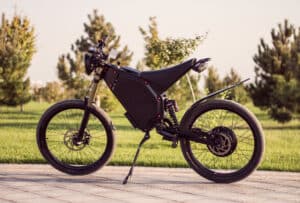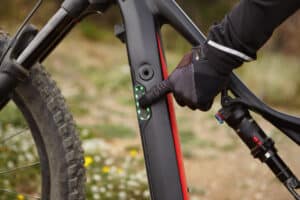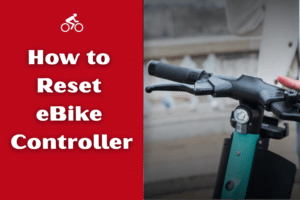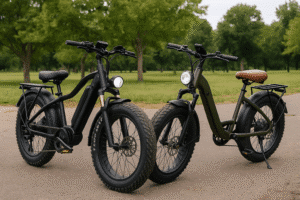A cadence sensor and a torque sensor can make the same e-bike feel completely different.
If you are trying to understand which one suits your riding style, it helps to know how each sensor responds to your pedaling.
I have ridden bikes with both systems, and the difference is clear from the first few minutes on the road.
Key Summary:
A cadence sensor gives steady power whenever the pedals are moving, which feels easy and relaxed but less natural. A torque sensor reacts to how hard you push, which feels smoother and more connected to your legs. If you want comfort with minimal effort, cadence works well. If you want a natural, responsive ride with better hill performance, torque is the better choice.
What Is a Cadence Sensor?
A cadence sensor measures how fast you turn the pedals and gives motor support based on your pedaling speed. It does not care how much pressure you apply. As long as the pedals are moving, the motor keeps helping.
A cadence sensor is the most common setup on entry-level and mid-tier e-bikes because it is simple and reliable.
It tracks your pedal rotations per minute and uses that number to trigger consistent power. The result is a steady push without needing much physical effort.
Many riders like cadence sensors because the bike feels easy from the moment it starts rolling.
If you want a relaxed ride on flat streets or you simply prefer light pedaling, a cadence sensor can feel comfortable and predictable.
How It Works
A cadence sensor counts each pedal rotation and sends a signal to the motor when you start pedaling. The faster your legs move, the more the controller adjusts the power within the assist level you choose. It is a speed-based system rather than an effort-based system.
It usually uses a small ring of magnets or an internal accelerometer. These components detect motion and communicate with the controller.
Here is what it measures:
- Pedal rotations per minute
- Whether the pedals are moving or stopped
- The assist level you selected
- Basic speed and cadence thresholds
This simple method is why cadence sensors are affordable and easy to maintain.
How It Feels When Riding
A cadence sensor gives a steady, almost cruise control-style feeling. Once you begin pedaling, the motor jumps in and keeps the bike moving with a consistent push. I often feel like the bike does most of the work when I ride a cadence-based system on flat terrain.
The support can feel a bit sudden at times, especially when starting from a stop or changing speeds.
On hills, it can also feel slower to react because the bike does not know that you are trying harder. It simply follows your pedal rotations.
Pros of Cadence Sensor:
- Very easy to use for beginners.
- Strong initial boost when starting from a standstill.
- Works well on flat roads or relaxed rides.
- Budget-friendly on most e-bikes.
- Simple design that usually needs little maintenance.
Cons of Cadence Sensor:
- Can feel robotic or less natural at times.
- Uses more battery because the motor stays active.
- Slower to respond when you need quick power on hills.
- Can feel jerky during starts and stops.
- Less control over fine adjustments in speed or effort.
What Is a Torque Sensor?
A torque sensor measures how much force you apply to the pedals and adjusts motor support based on your effort. The harder you push, the more the motor helps, which creates a smooth and natural riding feel.
A torque sensor reads your pedal pressure in real time and turns that into proportional assistance. It feels almost like the bike becomes an extension of your legs because the power comes in exactly when you need it.
I remember the first time I rode a torque-based bike and thought, this is the closest an e-bike can feel to a regular bicycle, only stronger.
Many higher-end commuter, mountain, and cargo e-bikes come with torque sensors because they offer better control, better hill performance, and better battery efficiency. Riders who want a responsive and engaging ride tend to prefer this system.
How It Works
A torque sensor sits in the bottom bracket, rear axle, or crankset. It measures how much pressure you put into each pedal stroke and sends that information to the motor controller. The system reacts instantly, boosting your effort in a smooth and controlled way.
In simple terms, the sensor checks:
- How much force you are applying
- How quickly you are pedaling
- Your selected assist level
- Changes in pedaling pressure from moment to moment
The controller uses all these signals to decide how much power to release. Since the help is based on your effort, the bike only gives the energy you actually need. This is why torque sensors tend to be more efficient and feel more natural on varied terrain.
How It Feels When Riding
Riding a torque sensor bike feels like your legs suddenly became stronger. Instead of a fixed push, the support changes instantly with your effort.
When I ride uphill on a torque-based bike, the motor reacts the moment I press harder, which makes the climb feel controlled and smooth.
The bike does not surge or lag because the sensor matches your input. This creates a steady, intuitive flow that many riders say feels closest to traditional cycling, just with extra power when needed.
Pros of Torque Sensor:
- Very natural and intuitive riding feel.
- Better battery efficiency because support is proportional.
- Smooth acceleration in stop-and-go situations.
- Excellent performance on hills and mixed terrain.
- Gives the rider more control over speed and power.
Cons of Torque Sensor:
- Usually found on more expensive e-bikes.
- Requires real pedaling effort to access higher power.
- Repairs can cost more if the sensor fails.
- Can feel tiring for riders who want effortless cruising.
- Not as common on budget friendly models.
Cadence Sensor vs Torque Sensor: What Are the Key Differences?
The main difference is that a cadence sensor measures how fast you turn the pedals, while a torque sensor measures how hard you push the pedals. Cadence sensors give steady power, but torque sensors give power based on your effort.
Both systems work well, but they feel very different in real riding. A cadence sensor keeps things easy and predictable, while a torque sensor makes the bike feel smooth and responsive.
Here is a simple comparison:
| Feature | Cadence Sensor | Torque Sensor |
|---|---|---|
| How it works | Measures pedal rotations per minute | Measures pedal pressure and force |
| Ride feel | Steady and consistent power | Natural and responsive support |
| Hill performance | Slower to react on climbs | Instant boost when you press harder |
| Battery efficiency | Uses more battery | More efficient because it matches effort |
| Price | Usually cheaper | Usually more expensive |
Which Sensor Is Better for Different Riders?
Different riders enjoy different styles of support, so the right sensor depends on how you like to pedal. Here is a simple way to choose based on your habits.
Choose a cadence sensor if you:
- Prefer light pedaling with minimal effort.
- Ride mostly on flat streets or paved bike paths.
- Want an affordable e-bike with simple controls.
- Like a steady push without thinking about pedal pressure.
- Enjoy relaxed cruising or daily short commutes.
Choose a torque sensor if you:
- Want a ride that feels natural and bike-like.
- Ride hills, mixed terrain, or stop-and-go city sections.
- Want better battery use and smoother power delivery.
- Prefer more control over speed based on your effort.
- Enjoy feeling connected to the bike through your pedaling.
Which Sensor Is Better for Different Types of Bikes?
Each bike category pairs better with a specific sensor because the riding purpose changes. Here is how the matchups usually look.
- Commuter bikes. Torque sensors feel great here because they react smoothly in traffic and save battery during longer rides.
- Mountain e-bikes. Torque sensors offer better control on climbs, tight turns, and uneven terrain where quick responses matter.
- Cargo e-bikes. Torque sensors help when carrying kids or heavy loads because the motor boosts pressure instantly during takeoff.
- Fat tire e-bikes. Cadence sensors work fine on flat recreation routes, although torque sensors feel smoother on sand or hills.
- Folding e-bikes. Cadence sensors keep the price low and make the bike easy for occasional riders.
- Budget city bikes. Cadence sensors keep things simple and cost-friendly.
Do Any E-Bikes Use Both Sensors?
Yes, some e-bikes use both cadence and torque sensors together. These hybrid systems read your pedal speed and pedal pressure at the same time, which creates a smoother and more precise response.
Manufacturers use dual sensor setups to give riders the best of both worlds. The torque sensor handles effort-based support, while the cadence sensor helps the controller react faster when you start pedaling or change your pace.
I have tried a few bikes with this system, and they feel very refined, especially during slow-speed maneuvers or city riding.
The combination usually appears on higher-quality or mid-drive models.
Final Words
Both sensors can make an e-bike enjoyable, but they create very different riding personalities. A cadence sensor keeps things easy, predictable, and budget-friendly, which works well for relaxed riders on flat terrain.
A torque sensor feels more natural and responsive, especially on hills or in busy city conditions. Your choice comes down to how much control you want and how you prefer the bike to react to your pedaling.
If you think about where you ride most and how much effort you want to put in, the right sensor becomes clear. That is the real key to choosing the e-bike that will feel best every single day.
Al Amin Morshed is the founder of BoltBikers and a seasoned e-bike reviewer with years of hands-on experience testing electric bikes. As a long-time e-bike enthusiast, he combines real-world riding insights with in-depth research to create honest, helpful content for riders of all levels. Through BoltBikers, Morshed aims to make e-biking more accessible, practical, and enjoyable – whether you’re a new rider or a daily commuter looking for the best gear.








